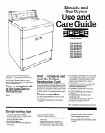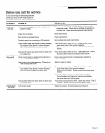
Common Laundering Problems, Continued
Problem Check if What to do
Slow
drying
There is a large amount of
moisture in the load to be dried.
Cold rinse water is used.
Room air temperature is below
45°F or 7.2%.
Dryer is exhausted according to Install and exhaust your dryer according to the Installation Instructions
Installation Instructions.
provided.
Lint screen is clogged. Clean lint screen before or after each use.
Proper electrical supply is used.
Properly connect the dryer to a grounded electrical circuit that meets
the electrical requirements stated in the Installation Instructions.
Modern dryer design is new to
you.
Static
electricity
Load is overdried.
Fabric softener was used.
Synthetics, synthetic blends,
permanent press and knits are
in load.
Some items hold more moisture than others (cottons more than
polyester). They take longer to dry. Full loads take longer to dry than
small loads of the same fabric. Low washer-spin speeds (recommended
for permanent press and lmits) remove less moisture than high-spin
speeds.
A load rinsed in cold water will take slightly longer to dry than a warm
one. Cold rinses, however, help save energy and reduce wrinkling
more than warm rinses do.
Install dryer in a room where the air temperature is warmer than 45°F or
7.2%. Cold air increases drying time and may cause wrinkles not to be
removed.
Your modem dryer is designed for the care of modern fabrics. Drying
temperatures are lower than in older models. The cool-down time at
the end of each drying cycle helps reduce wrinkling and makes clothes
easier to handle, but it may take longer to dry than you are used to.
Remove items while there is still a trace of moisture.
Use a “less dry” setting if your dryer has an automatic dryness sensor.
Follow manufacturer’s product directions carefully.
Synthetics, synthetic blends, permanent press and knits build up static
electricity. Use a fabric softener and be careful not to overdry the load.
Page 9














